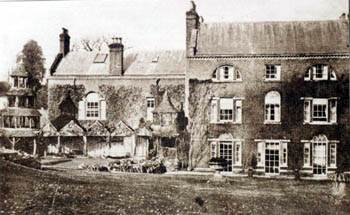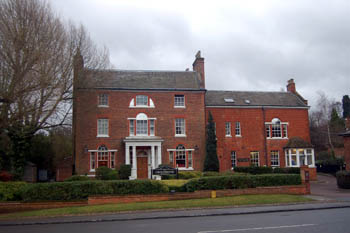Moore Place Aspley Guise

The Holt about 1900 [Z818/5]
Moore Place lies in The Square abutting Woburn Lane. It was listed by the Department of Environment, who noted that it had been built about 1786 for Francis Moore and that it had been altered and extended in the 19th century. It is constructed of red brick laid in headerbond, most of the bricks are vitrified with red brick dressings. The roof is slated. The large window in the centre of the second floor is referred to in the listing as a Diocletian window.
Francis Moore came from Somerset and attended the Aspley Guise Classical Academy. Whilst still a pupil at the school he showed the right kind of aptitude to get on in life by marrying Susanna Sawell, daughter of the headmaster; this was in 1766. In 1770 Sawell died and Moore, through his daughter, inherited a share of his estate. For the next fourteen years Moore conducted a feud with Richard How the younger of The Old House. This arose because Moore packed a vestry meeting and attempted to get Richard How the elder's land assessed for payment of the parish poor rate (money collected for distribution amongst the poor on a pro rata basis from land and property owners in the parish) at an unfairly high level. The younger How accused Moore of falsely accusing his father of "ruling the parish" and that he: "insulted him grossly by Expression of Contempt, laughter, virulent invective, and the charge of fraud and dishonesty". Moore was an aggressive young man who obviously thrived on discord and ambition. It is to him, however, that Aspley Guise and even more, Aspley Heath, owed their Victorian and Edwardian fame as health resorts. This was because Francis Moore bought up land on Wavendon Heath, in what was later to become Aspley Heath and, around 1778, planted 500 acres of it with 51,376 Scotch firs, for which he received a gold medal from the Society for the Encouragement of Art and Manufactures. Moore subsequently sold the 500 acres to the Duke of Bedford, in 1792, for £17,116, a truly vast sum for those days. Francis Moore was succeeded at Moore Place by his son John Patrick and he by his son, John Vaux Moore, Rector of Aspley Guise from 1844 until his death in 1864.

Rear of The Holt about 1900 [Z818/6]
In 1927 this part of Bedfordshire was valued under the terms of the Rating Valuation Act 1925; every piece of land and building had to be inspected to determine the rates to be paid on it [DV1/C/141]. At this time the building was called The Holt. The owner and occupier was the wonderfully named Captain Courage and the house stood in nearly three acres. The valuer detailed a hall (13 feet by 9½ feet) downstairs, with a study (14 feet by 14½ feet), drawing room (25 feet by 16½ feet), dining room (22 feet by 15 feet), morning room (14 feet by 12 feet), pantry, kitchen (18 feet by 15 feet), scullery and servants' hall ("small"). Upstairs were a bedroom (16½ feet by 14½ feet), bathroom, a bedroom 916½ feet by 15 feet), another bathroom and a further bedroom (25 feet by 19½ feet), a housemaid's sink and a wc, a further bedroom (12½ feet by 14 feet), a dressing room and a final bedroom (13 feet by 14½ feet). On the second floor were six bedrooms ("not attics, 2nd floor") and a bathroom. Outside were a brick and slate coal hovel, a garage, a timber cycle shed, a brick and slate workshop, a stable for three horses, a coach house, three loose boxes, a brick, corrugated iron and slate barn and loft, a brick and slate potting shed and two heated glasshouses (13½ feet by 35 feet and 14 feet by 10 feet). Mains drainage, water and gas were all laid on and central heating was installed. The valuer commented: "Most wonderful holly hedge on the land side. Was a Boarding House for a few years - got into trouble with licensing laws. Barrack of a place. Overlooked by road. Stabling good".
With The Holt went a cottage in West Hill tenanted by Andrew Smith consisting of two living rooms and a kitchen downstairs with three bedrooms above; a barn, wash house and wc were outside. Like the big house mains water, drainage and gas were laid on. With this house went a corrugated iron and slate barn ("v.large") and a brick and slate stable for three, dairy and store.
The 1927 valuer's reference to a boarding house is interesting. It is difficult to know when it happened but to be referred to by a valuer in 1927 it must have happened within, say, twenty years and the likeliest time seems to be either some time between 1903 and 1914 as the Kelly's Directory for 1910 lists no occupier or during or just after the First World War as the Kelly's for 1920 again lists no occupier (there were no directories during the war). Moore Place has had a history which oscillates between private and commercial use. It changed from a private residence, to a boarding house back to a private residence, then into an Old People's Home and finally, late in the 20th century into a hotel and restaurant, which it remains at the time of writing [2008]. It was when the use of the building changed to a hotel that the name reverted to Moore Place.
Directories reveal the following occupiers of The Holt, as it then was for the dates specified: 1885-1898: Henry Paul Harris JP; 1903: Stanley Harris JP; 1914: Walker James Croxton; 1924: Ivor Forbes Malcolmson; 1928-1931: John Hubert Courage.
 Moore Place in January 2008
Moore Place in January 2008